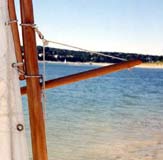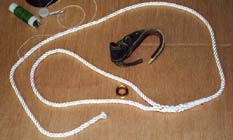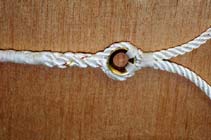|
The Sea Chest |

|
The Snotter maybe the least attractive of all nautical
terms and therein lies its beauty…. well, to
the six-year-old in me anyway. I must confess to taking
a perverse pleasure in saying to my unwary companion
in the boat, “Grab that snotter and give it
a yank” or “See if you can squeeze a bit
more from that snotter.” I always did this with
a straight face and with serious tone in my voice,
while inside my head the six-year-old doubled up with
laughter. It’s not something I’m proud
of but I did it and if I still had a boat that used
a snotter I would again.
For those not familiar with this particular nautical
term let me explain: a snotter is a line used to capture
or adjust either a sprit boom or the sprit in the
Sprit Sail. Why is it called a snotter? I can’t
answer that…. the six-year-old in my head could
but I won’t allow it.
 |
 |
Figure
1 |
Figure
2 |
| (click
images to enlarge) |
|
There are many variations of snotters and one of
the great joys of traditional sails is this variety.
The snotter in Figure 1 allows the
sprit boom on a Sliding Gunter to be adjusted from
the helm. In this case the snotter pushes the sprit
down and out. But in Figure 2, the
snotter for a Sprit Sail pushes the sprit up and out.
The snotter in Figure 2 is a snotter
shown in Pete Culler’s Skiffs
and Schooners (published by International
Marine). He stated he had seen it nowhere but on his
boats but was quick to add, “… being simple
and practical, it was worked out long ago, I’m
sure.”
 |
 |
Figure
3a |
Figure 3b |
|
| Figure
3c
|
|
I had to look at this “simple and practical”
snotter for awhile before I figured out a way to make
it. When I finally figured out a way to make it I
had to ask myself why it took me so long because it’s
so simple.
Start with a simple eye splice like Figure 3a but
you’ll want to make sure that the loop in large
enough to go around the mast. However, not so large
that it doesn’t allow for enough uptake on the
sprit. Once all that is accomplished jam the thimble
into the crotch of the eye splice and seize it in
place like Figure 3b. Now all that is left is to determine
how long the tail should be. Do this on the boat with
snotter and sprit. It’s that simple. Figure
3c shows the finished snotter.
Don’t know how to make an eye splice? Well,
marlinspike skills are something every sailor and
waterman should know but if you don’t, all is
not lost. Create a loop by seizing the working end
to the standing part and press on. It will work just
as well but won’t be as pretty….. but
you really should know how to make an eye splice…
it’s not hard, really.
This is just one of several possible ways to make
the Culler snotter and the Culler snotter is just
one of many variations used to control and capture
the sprit. As with all traditional sails, there is
no right or wrong way as long as it does the job of
controlling the sprit.
Personally, I think everyone should have a sprit
boom or sprit if for no other reason than to be able
to say “Hunker down on that snotter and push
it out” or “grab that snotter and sweat
it up”. The real reason, of course, is the sails
that use a snotter are simple, efficient, and well
suited to small boats but if there is a six-year-old
on board, the snotter has been known to keep them
entertained for hours.
By the way, thimbles
are great to have because you can make so much gear
with them including snotters. I always keep a few
in the bottom of my marlinspike kit.

Be sure to get your copy
of David's book:
"The
Working Guide to Traditional Small-Boat Sails"
|